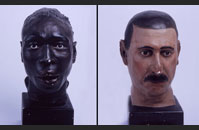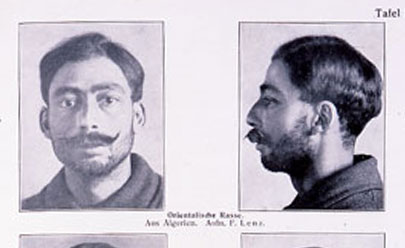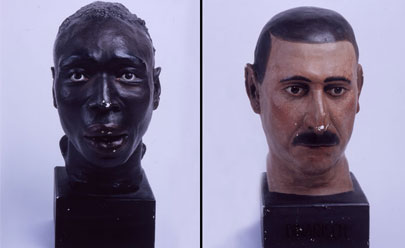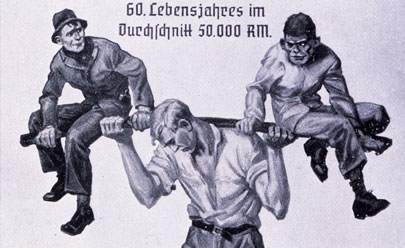SPECIAL EXHIBITS: DEADLY MEDICINE
July 25 – October 15, 2012
On view in the Joe W. and D.D. Brown Foundation Special Exhibit Gallery
Produced by the United States Holocaust Memorial Museum
Sponsored locally by the Tulane School of Medicine
A thought-provoking exhibit and related programs that examine the complicity of physicians and scientists in Nazi racial health policies.
From 1933 to 1945, Nazi Germany carried out a campaign to “cleanse” German society of people viewed as biological threats to the nation’s “health.” Enlisting the help of physicians and medically trained geneticists, psychiatrists and anthropologists, the Nazis developed racial health policies that started with the mass sterilization of “hereditarily diseased” persons and ended with the near annihilation of European Jewry. Deadly Medicine: Creating the Master Race traces this history from the early 20th-century international eugenics movement to the Nazi regime’s “science of race.” It also challenges viewers to reflect on the present-day interest in genetic manipulation that promotes the possibility of human perfection.
Learn more about the public programming associated with this exhibit.
Images:
 Dr. Otmar von Verschuer examines twins at the Kaiser Wilhelm Institute. As the head of the Kaiser Wilhelm Institute’s Department for Human Heredity, Verschuer, a physician and geneticist, examined hundreds of pairs of twins to study whether criminality, feeble-mindedness, tuberculosis, and cancer were inheritable. In 1927, he recommended the forced sterilization of the “mentally and morally subnormal.” Verschuer typified those academics whose interest in Germany’s “national regeneration” provided motivation for their research.
Dr. Otmar von Verschuer examines twins at the Kaiser Wilhelm Institute. As the head of the Kaiser Wilhelm Institute’s Department for Human Heredity, Verschuer, a physician and geneticist, examined hundreds of pairs of twins to study whether criminality, feeble-mindedness, tuberculosis, and cancer were inheritable. In 1927, he recommended the forced sterilization of the “mentally and morally subnormal.” Verschuer typified those academics whose interest in Germany’s “national regeneration” provided motivation for their research.
 Family histories created by staff at a German institution for “feebleminded” persons. After 1933, the cards were presented to new “Heredity Health Courts” to support the sterilization of “genetically diseased” persons.
Family histories created by staff at a German institution for “feebleminded” persons. After 1933, the cards were presented to new “Heredity Health Courts” to support the sterilization of “genetically diseased” persons.
 “Don’t Go Blindly into Marriage!” Eugenics had the support of many scientists worldwide, including the U.S. This drawing illustrated a 1924 pamphlet that urged couples to be informed about the health, including genetic health, of prospective spouses. This image was first published by Louisiana’s Department of Health.
“Don’t Go Blindly into Marriage!” Eugenics had the support of many scientists worldwide, including the U.S. This drawing illustrated a 1924 pamphlet that urged couples to be informed about the health, including genetic health, of prospective spouses. This image was first published by Louisiana’s Department of Health.
 Head shots showing various racial types. Most western anthropologists classified people into “races” based on physical traits such as head size and eye, hair and skin color. This classification was developed by Eugen Fischer and published in the 1921 and 1923 editions of “Foundations of Human Genetics and Racial Hygiene.”
Head shots showing various racial types. Most western anthropologists classified people into “races” based on physical traits such as head size and eye, hair and skin color. This classification was developed by Eugen Fischer and published in the 1921 and 1923 editions of “Foundations of Human Genetics and Racial Hygiene.”
 “You Are Sharing the Load! A Hereditarily Ill Person Costs 50,000 Reichsmarks on Average up to the Age of Sixty,” reproduced in a high school biology textbook by Jakob Graf. The image illustrates Nazi propaganda on the need to prevent births of the “unfit.”
“You Are Sharing the Load! A Hereditarily Ill Person Costs 50,000 Reichsmarks on Average up to the Age of Sixty,” reproduced in a high school biology textbook by Jakob Graf. The image illustrates Nazi propaganda on the need to prevent births of the “unfit.”
 Dr. Ernst Wentzler treats a child with rickets. Dr. Wentzler’s Berlin pediatric clinic served many wealthy families and high-ranking Nazi officials. Although Wentzler developed methods to treat premature infants or children with severe birth defects, he supported ending the lives of the “incurably ill” and served as a primary coordinator of the pediatric “euthanasia” program, evaluating patient forms and ordering the killing of several thousand children.
Dr. Ernst Wentzler treats a child with rickets. Dr. Wentzler’s Berlin pediatric clinic served many wealthy families and high-ranking Nazi officials. Although Wentzler developed methods to treat premature infants or children with severe birth defects, he supported ending the lives of the “incurably ill” and served as a primary coordinator of the pediatric “euthanasia” program, evaluating patient forms and ordering the killing of several thousand children.
 Heads of racial types, created by anthropologists from plaster molds of the faces of living subjects, were mass-produced in Nazi Germany for use in exhibits and racial hygiene classes. These heads portray “Negro” racial type and the “Dinaric” (Balkan) racial type.
Heads of racial types, created by anthropologists from plaster molds of the faces of living subjects, were mass-produced in Nazi Germany for use in exhibits and racial hygiene classes. These heads portray “Negro” racial type and the “Dinaric” (Balkan) racial type.
 Students at the Berlin School for the Blind examine racial head models circa 1935. Students were taught Gregor Mendel’s principles of inheritance and the purported application of those laws to human heredity and principles of race. During the Third Reich, German born deaf or blind, like those born with mental illnesses or disabilities, were urged to submit to compulsory sterilization as a civic duty.
Students at the Berlin School for the Blind examine racial head models circa 1935. Students were taught Gregor Mendel’s principles of inheritance and the purported application of those laws to human heredity and principles of race. During the Third Reich, German born deaf or blind, like those born with mental illnesses or disabilities, were urged to submit to compulsory sterilization as a civic duty.





